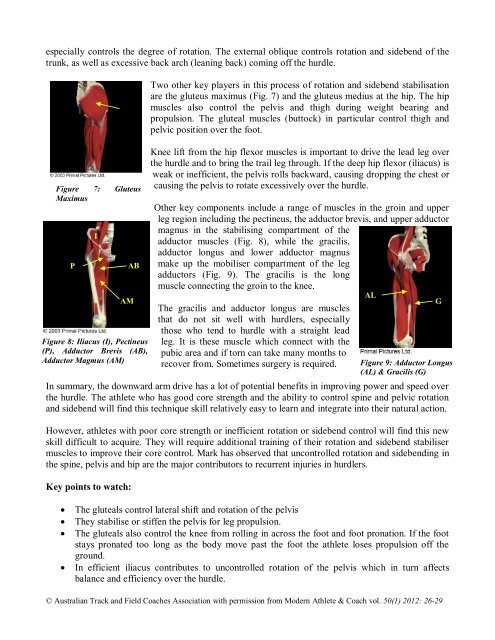Hurdle Performance: lead arm technique advancement - The ...
Hurdle Performance: lead arm technique advancement - The ...
Hurdle Performance: lead arm technique advancement - The ...
You also want an ePaper? Increase the reach of your titles
YUMPU automatically turns print PDFs into web optimized ePapers that Google loves.
especially controls the degree of rotation. <strong>The</strong> external oblique controls rotation and sidebend of the<br />
trunk, as well as excessive back arch (leaning back) coming off the hurdle.<br />
Figure 7: Gluteus<br />
Maximus<br />
P<br />
I<br />
AB<br />
B<br />
AM<br />
M<br />
Figure 8: Iliacus (I), Pectineus<br />
(P), Adductor Brevis (AB),<br />
Adductor Magmus (AM)<br />
Two other key players in this process of rotation and sidebend stabilisation<br />
are the gluteus maximus (Fig. 7) and the gluteus medius at the hip. <strong>The</strong> hip<br />
muscles also control the pelvis and thigh during weight bearing and<br />
propulsion. <strong>The</strong> gluteal muscles (buttock) in particular control thigh and<br />
pelvic position over the foot.<br />
Knee lift from the hip flexor muscles is important to drive the <strong>lead</strong> leg over<br />
the hurdle and to bring the trail leg through. If the deep hip flexor (iliacus) is<br />
weak or inefficient, the pelvis rolls backward, causing dropping the chest or<br />
causing the pelvis to rotate excessively over the hurdle.<br />
Other key components include a range of muscles in the groin and upper<br />
leg region including the pectineus, the adductor brevis, and upper adductor<br />
magnus in the stabilising compartment of the<br />
adductor muscles (Fig. 8), while the gracilis,<br />
adductor longus and lower adductor magnus<br />
make up the mobiliser compartment of the leg<br />
adductors (Fig. 9). <strong>The</strong> gracilis is the long<br />
muscle connecting the groin to the knee.<br />
AL<br />
<strong>The</strong> gracilis and adductor longus are muscles<br />
that do not sit well with hurdlers, especially<br />
those who tend to hurdle with a straight <strong>lead</strong><br />
leg. It is these muscle which connect with the<br />
pubic area and if torn can take many months to<br />
recover from. Sometimes surgery is required.<br />
Figure 9: Adductor Longus<br />
(AL) & Gracilis (G)<br />
In summary, the downward <strong>arm</strong> drive has a lot of potential benefits in improving power and speed over<br />
the hurdle. <strong>The</strong> athlete who has good core strength and the ability to control spine and pelvic rotation<br />
and sidebend will find this <strong>technique</strong> skill relatively easy to learn and integrate into their natural action.<br />
However, athletes with poor core strength or inefficient rotation or sidebend control will find this new<br />
skill difficult to acquire. <strong>The</strong>y will require additional training of their rotation and sidebend stabiliser<br />
muscles to improve their core control. Mark has observed that uncontrolled rotation and sidebending in<br />
the spine, pelvis and hip are the major contributors to recurrent injuries in hurdlers.<br />
Key points to watch:<br />
<strong>The</strong> gluteals control lateral shift and rotation of the pelvis<br />
<strong>The</strong>y stabilise or stiffen the pelvis for leg propulsion.<br />
<strong>The</strong> gluteals also control the knee from rolling in across the foot and foot pronation. If the foot<br />
stays pronated too long as the body move past the foot the athlete loses propulsion off the<br />
ground.<br />
In efficient iliacus contributes to uncontrolled rotation of the pelvis which in turn affects<br />
balance and efficiency over the hurdle.<br />
© Australian Track and Field Coaches Association with permission from Modern Athlete & Coach vol. 50(1) 2012: 26-29<br />
G


